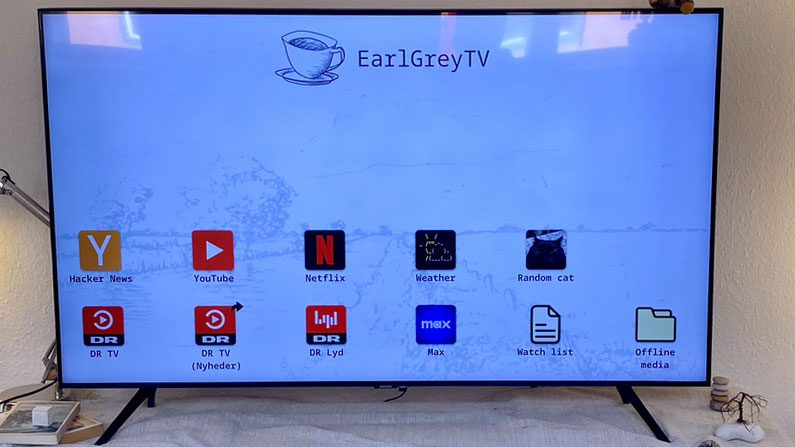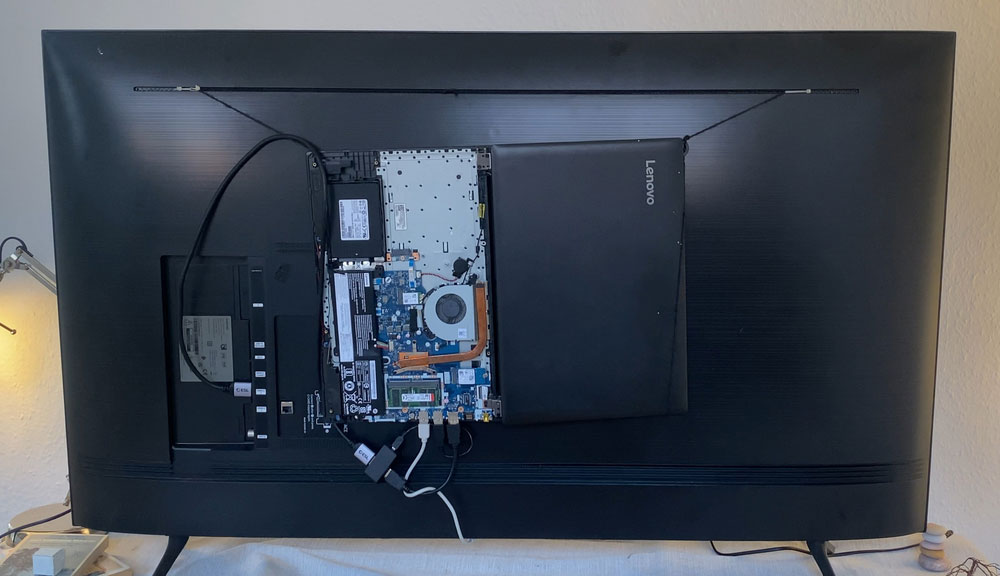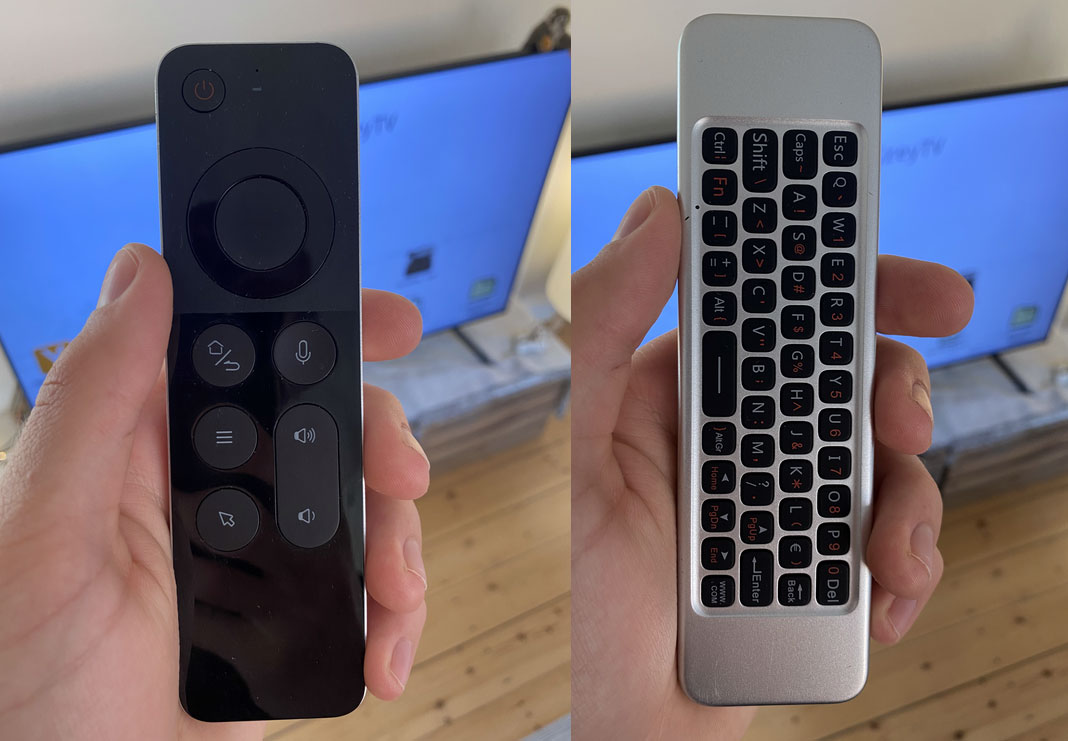Custom Linux-powered Smart TV breaks free from ads and tracking, enables ultimate customizability — EarlGreyTV straps a laptop to the back to unlock unlimited control
But this project might not be the prettiest thing.

Software engineer Carl Riis has announced his first hardware project, dubbed EarlGreyTV. It is a Smart TV project that differentiates itself from the usual ‘idiot box’ dominating your living room by leveraging the wonders of Linux and Firefox, plus an old laptop. Though Riis humbly admits that EarlGreyTV doesn’t compete with today’s state-of-the-art domestic solutions in every way, it has a few worthwhile advantages — customizability, control, and privacy.
Riis was inspired to create EarlGreyTV because he “didn’t really like existing Smart TV interfaces.” Perhaps more importantly, he added, “The short version of why I don’t like them is tracking, ads, and lack of control.” The concept behind EarlGreyTV is easy to understand, but the project wasn’t without its stumbling blocks. It took a modicum of finessing on both the hardware and software sides of the equation to get the project to a point where it works well for non-techy people.
An essential part of the work behind this project was on software. The old spare laptop used to power this Smart TV experience had Debian Linux with Sway as a desktop environment installed. Sway was set to auto-launch Firefox full screen and open up a custom EarlGreyTV HTML file, which provided easily editable and navigable shortcuts to all the content Riis wanted. He also worked on essential related Smart-TV-esque UI elements like volume change notifications, casting, and more.
Users also take several Smart TV behaviors for granted, all needing work. Probably one of the most significant differences a ‘normal’ Start TV user will feel is in the remote. To stay away from the default yet clunky mouse and keyboard solution, Riis chose an ‘air mouse’ (a WeChip W3), which has a gyroscopic pointer and a few shortcut buttons on the front – plus a QWERTY keyboard on its back. Home, back, and volume controls are very important to TV users and present on the WeChip W3. Riis never mentions if his EarlGreyTV uses the voice remote features, though.
In addition to the TV and remote, a CEC adaptor is useful for the seamless operation of the EarlGreyTV. In brief, this adaptor sends commands to the TV via the HDMI connection. The key benefit of adding this to the setup is that it means this TV can be controlled with one remote. Thus, the original Samsung TV remote isn’t needed to turn the TV on and off.
Many readers will have a spare, disused, possibly somehow damaged old laptop like Riis uses as the brains behind the EarlGreyTV. In the images, you can see an old, partly disassembled Lenovo laptop stuck to the rear of the Samsung TV. This device’s keyboard broke after Riis spilled Earl Grey tea on it a couple of years ago – hence the name of this project. Nevertheless, it is OK for this project to use the ‘air mouse’ as an input device. One drawback of this damaged laptop model is that it can only be powered up by shorting two pins on the mainboard.
Riis is keen to dispel concerns that a Linux-based SmartTV is a particularly complicated device or a challenging project. If you want to make your own EarlGreyTV or base another project upon this one, you can find some guidance on the blog post and even grab some supporting code from GitHub.
Get Tom's Hardware's best news and in-depth reviews, straight to your inbox.

Mark Tyson is a news editor at Tom's Hardware. He enjoys covering the full breadth of PC tech; from business and semiconductor design to products approaching the edge of reason.
-
pixelpusher220 Definitely a good step. I think though that at least modern TVs are now 'scanning' what's being displayed so they'd still be able to track via that methodReply
https://digiday.com/future-of-tv/wtf-is-automatic-content-recognition/ -
Math Geek that would be true if the tv's built in wifi is being used. but i am assuming the laptop's wifi card is what is being used here. this would not give the tv any way to upload the data it may be gathering that way. the only outgoing data is through the laptop and that's not going to let the tv connectReply -
Math Geek if you have your network running through it before leaving the house, then sure you can block anything you wish.Reply
pi hole is another popular method to block a lot of unwanted traffic. i have my phone connecting to a vpn i set up at my house which then goes through a pi hole before heading out to the open web. i block all that google/amazon/facebook/etc/etc/etc spying on the phone that way. pc's also enjoy a lot more privacy from MS windows spyware edition they're forcing on people now.
you do of course have to spend the time to create the black list or gather some pre made lists off the web., mine is set to auto-block everything until i allow it. i prefer it that way, easier to keep tabs on things when it has to ask permission. -
USAFRet I do similar with a small Beelink Win 10 system.Reply
The TV is just a display panel. None of its "smart" features are used. -
Math Geek my pc is connected by hdmi, so same for me. the tv itself is not connected to the network. everything comes through the pcReply -
LabRat 891 HTPC w/ even more steps.Reply
Amazing, how 'SmartTVs' were supposed to be so convenient. -
Math Geek smart tv's are convenient overall. they do suffer from some common long term problems but to just connect to the network, log in the various services you use and then watch in one place is rather easy to do.Reply
over time though the OS stops getting updates and the apps stop working due to not being updated either. so over a couple years, your smart features stop being so smart.
so a laptop connected or a roku/firestick/apple tv type thing plugged in can bring it back up to date and working again.
and of course the data collection is excessive, but then it's excessive everywhere which makes something like a pi-hole almost needed if you care at all about your privacy. -
ThomasKinsley A laptop plugged into a dumb TV is far smarter and more enjoyable to use while relatively preserving privacy. Especially if it's an older laptop with W7 or Linux on it.Reply -
ezst036 ReplyAdmin said:Riis is keen to dispel concerns that a Linux-based SmartTV is a particularly complicated device or a challenging project
This wouldn't be necessary if but for some users who spread F.U.D. from days long since passed in regard to using Linux.
But I do wish him well. He is up against a massive army on this that do not want the truth known that Linux is one of the easiest things out there you can use. Far easier to use than just about all things, except for maybe a Macintosh.
I like this project, and I hope the second revision is a lot more buttoned up than a laptop hanging from the back of a TV. There are way too many devices and too much software spying on people these days. Linux is the answer for putting an end to the spying. Linux does not solve all problems - but it definitely solves this one.


